As AI tools become more common, they’re changing how people search, delivering direct, personalized answers, often without sending users to other websites.
That means digital marketing is shifting—from chasing clicks to building brand visibility and trust right inside the AI’s answer.
Think of it this way: traditional SEO was like competing to have the best storefront on a busy street. GEO is like making sure the local tour guide knows about your business and recommends it to visitors.
In this guide, you’ll learn how to get your brand noticed in the era of AI-powered search and how to track your AI visibility.
Here’s why every marketer needs to understand GEO right now:
One: 16% of all US searches now show AI Overviews (more than doubled since March 2025). That’s roughly 1 in 6 searches where Google answers search queries directly on the search page through AI Overviews instead of directing them to websites. 97% of those queries are informational, which is one of SEO’s main focuses.
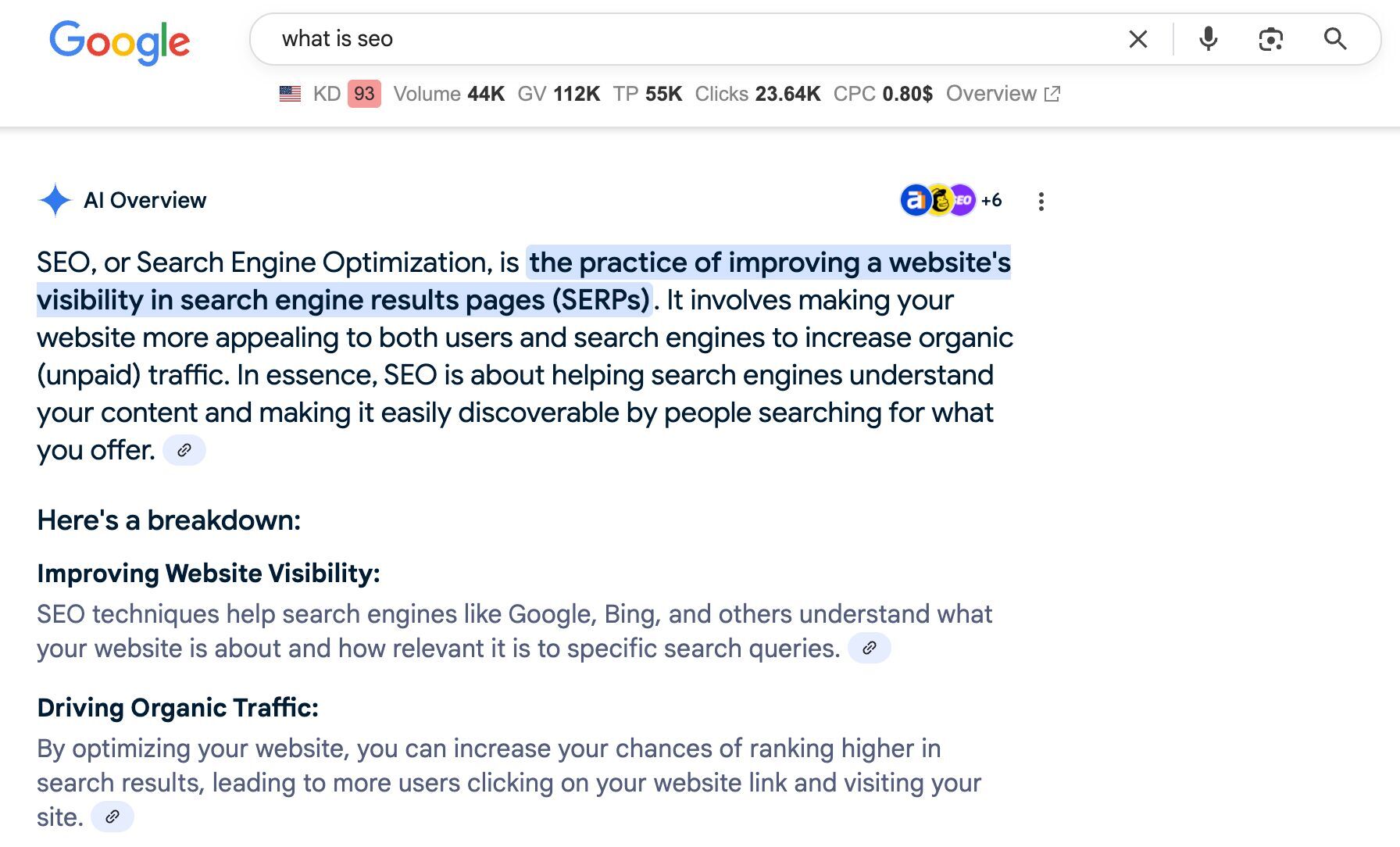
Two: when an AI Overview appears, the top search result sees a 34.5% drop in clicks—a built-in change that can cause a big traffic hit for any site on the web.
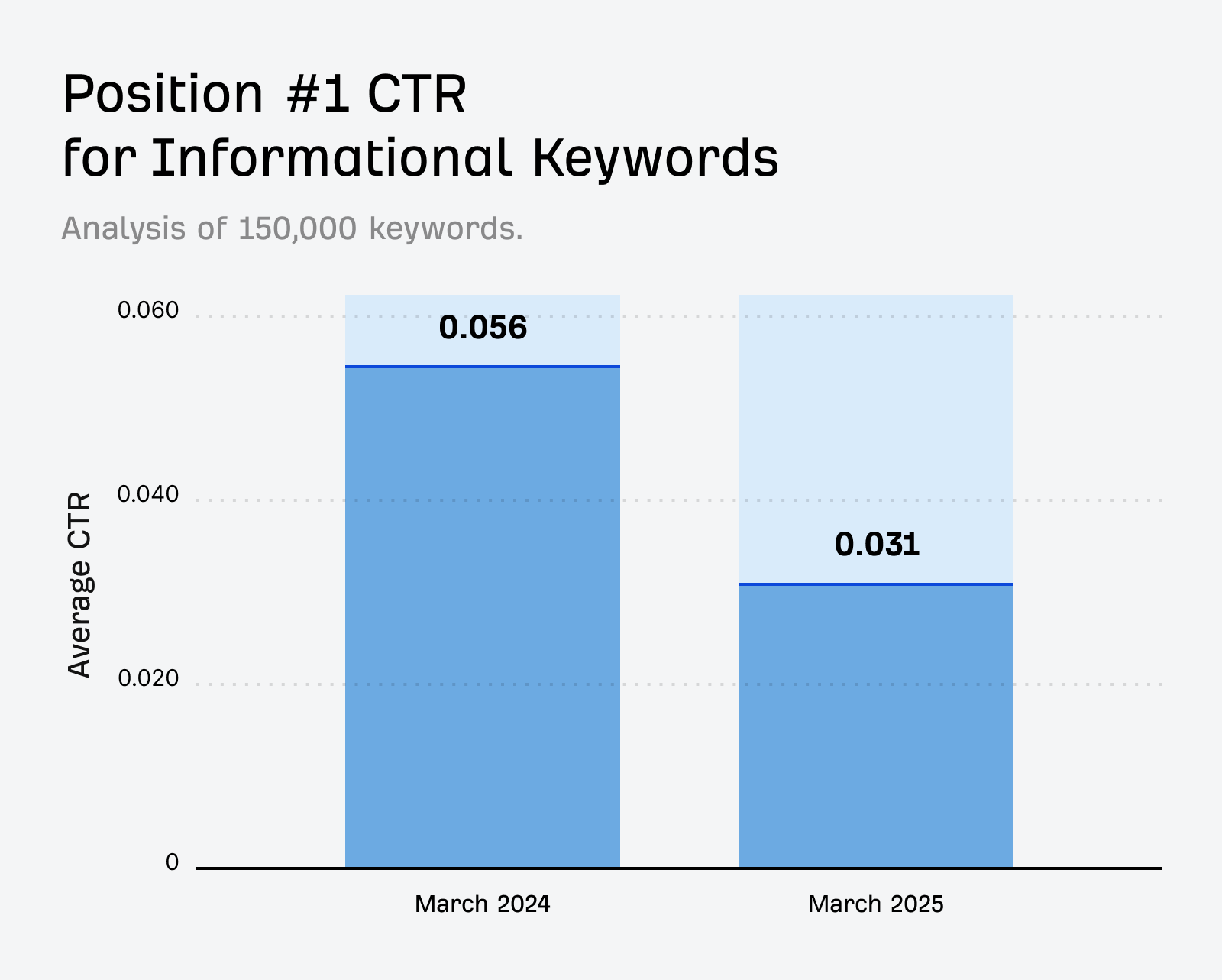
Three: all major AI assistants can search the web, making them a new alternative to Google. The problem is, like AI Overviews, they answer the question instantly and don’t always link to the products or services they mention (and people don’t always click).
But before you panic about completely overhauling your marketing strategy, here’s the good news:
AI still relies on traditional search. AI assistants use something called RAG (Retrieval-Augmented Generation), which means they actively search Google, Bing, and other search engines to find current information. So if you’re already ranking well in traditional search, you’re already in the running for AI citations and mentions.
Higher conversion rates may be the silver lining. I’ve seen numerous reports on LinkedIn and experienced this ourselves at Ahrefs—AI-driven traffic converts better (23 times in our case) than traditional search traffic. While the volume is smaller, the quality appears to be higher.
Google says don’t panic. Gary Illyes stated that specialized “AI SEO” isn’t necessary to rank in AI Overviews or the new AI Mode. Good content and solid SEO fundamentals still matter most. You don’t need to throw out everything you know about search marketing.
AI search is changing the game, but it’s building on the same foundation you’re already working with.
In fact, you can gain AI visibility through “traditional” SEO, and vice versa. Ahrefs’ content and product pages have been mentioned 7,470 times across 2,309 pages, without any effort to optimize them for AI visibility. It makes sense when you think about it: every new type of search is built on existing forms of content.
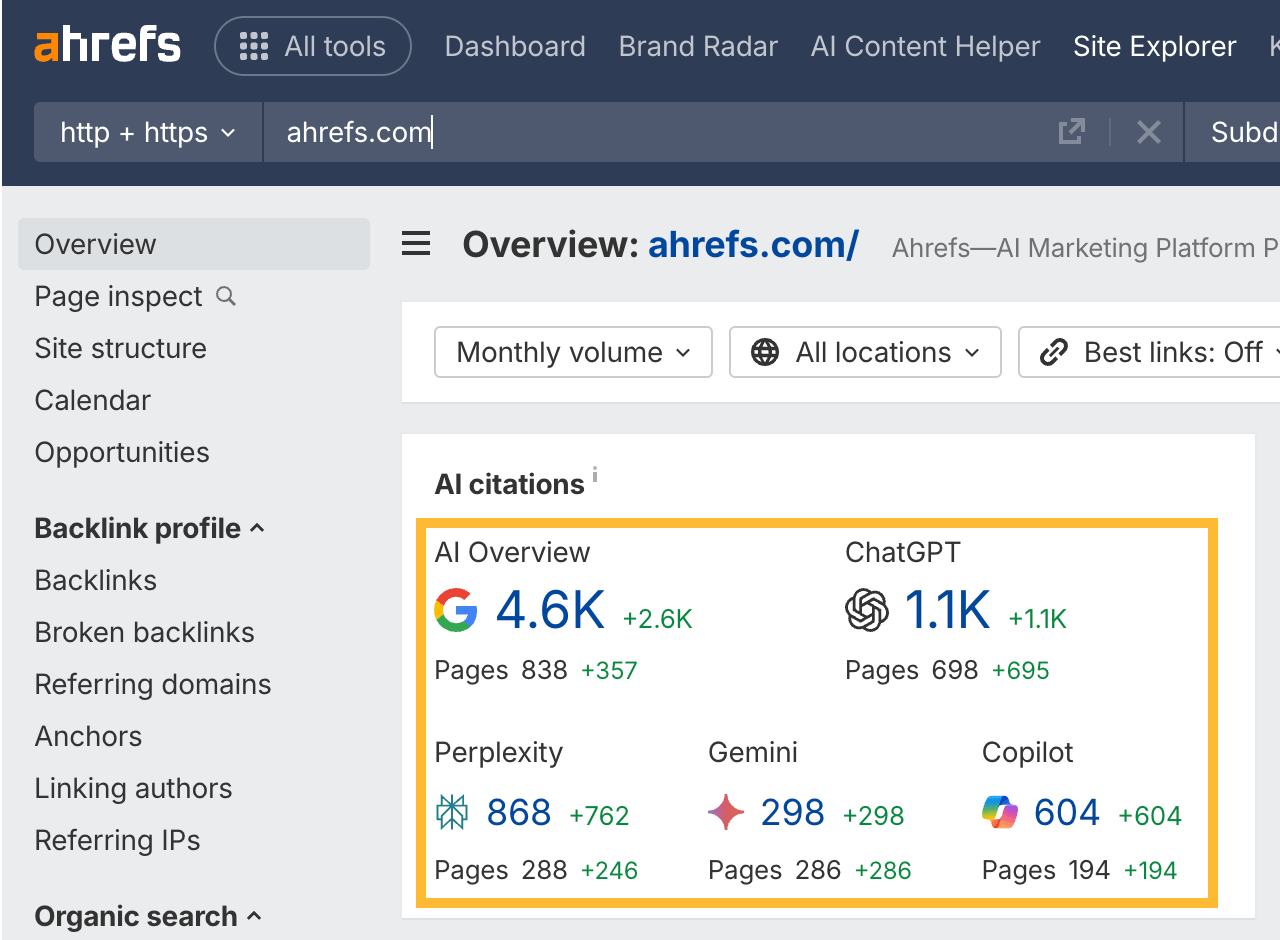
There are some differences, though.
In a nutshell, traditional search gives you a list of links to explore, while AI search gives you direct answers. Traditional search is about competing for clicks, while AI search is about being cited within the answer itself. Users go from “click and explore” to “ask and receive.”
| Aspect | SEO (Search Engine Optimization) | GEO (Generative Engine Optimization) |
|---|---|---|
| Objective | Focuses on helping websites rank higher in traditional search engines like Google or Bing to attract more clicks. | Focuses on increasing your brand’s visibility in AI-generated answers—making sure you’re part of the conversation, even if users never click through to your site. |
| Content goal | Aims to bring users to your website. | Aims to ensure AI tools accurately mention and represent your brand, even if the user gets all the information they need without visiting your site. |
| Authority signals | Often comes from backlinks or how long your domain has been around. | Comes from consistently appearing across trusted platforms, being recognized by experts, and having clear, up-to-date, fact-based content that AI tools can easily understand and use. |
| Response type | List of ranked links. | Direct, summarized answers. |
| Interaction style | Short search queries, click-based. | Conversational, long prompts, often no clicks needed. |
| Data source | Web pages indexed and ranked. | Combines information using built-in knowledge + search (RAG). |
Now for the practical stuff. Succeeding with GEO requires mixing solid SEO fundamentals with tactics borrowed from other marketing disciplines. Here’s your action plan:
1. Get mentioned across the web
This may surprise you: most mentions of your brand will likely come from other websites, not your own.
When I looked at the top sources for Ahrefs’ brand mentions in AI responses, third-party sites dominated. For example, in Google’s AI Overviews, the top pages mentioning Ahrefs didn’t include ahrefs.com at all.

Perplexity was the only assistant that listed our page as one of the top sources mentioning our brand, but not as the main source.
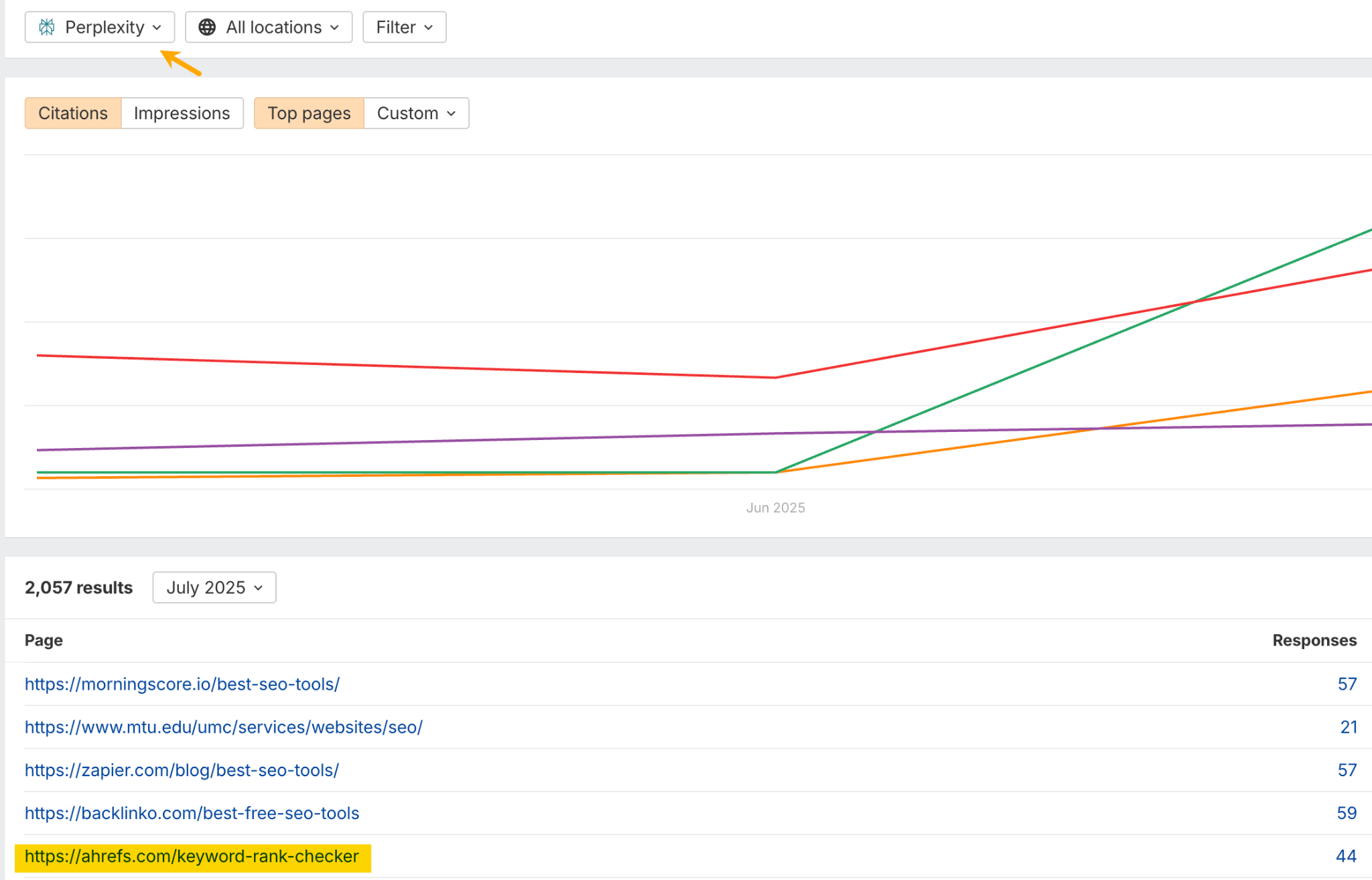
This means you need to focus on getting mentioned across the web through:
- Industry rankings and lists: get included in “best of” lists and industry roundups.
- PR and media coverage: traditional PR becomes even more valuable in the AI era.
- Reviews and case studies: encourage customers to mention your brand in reviews.
The big difference from traditional link building is that these mentions don’t need to be linked. AI can pick up unlinked brand references just as easily, as our research on Google AI Overviews shows.
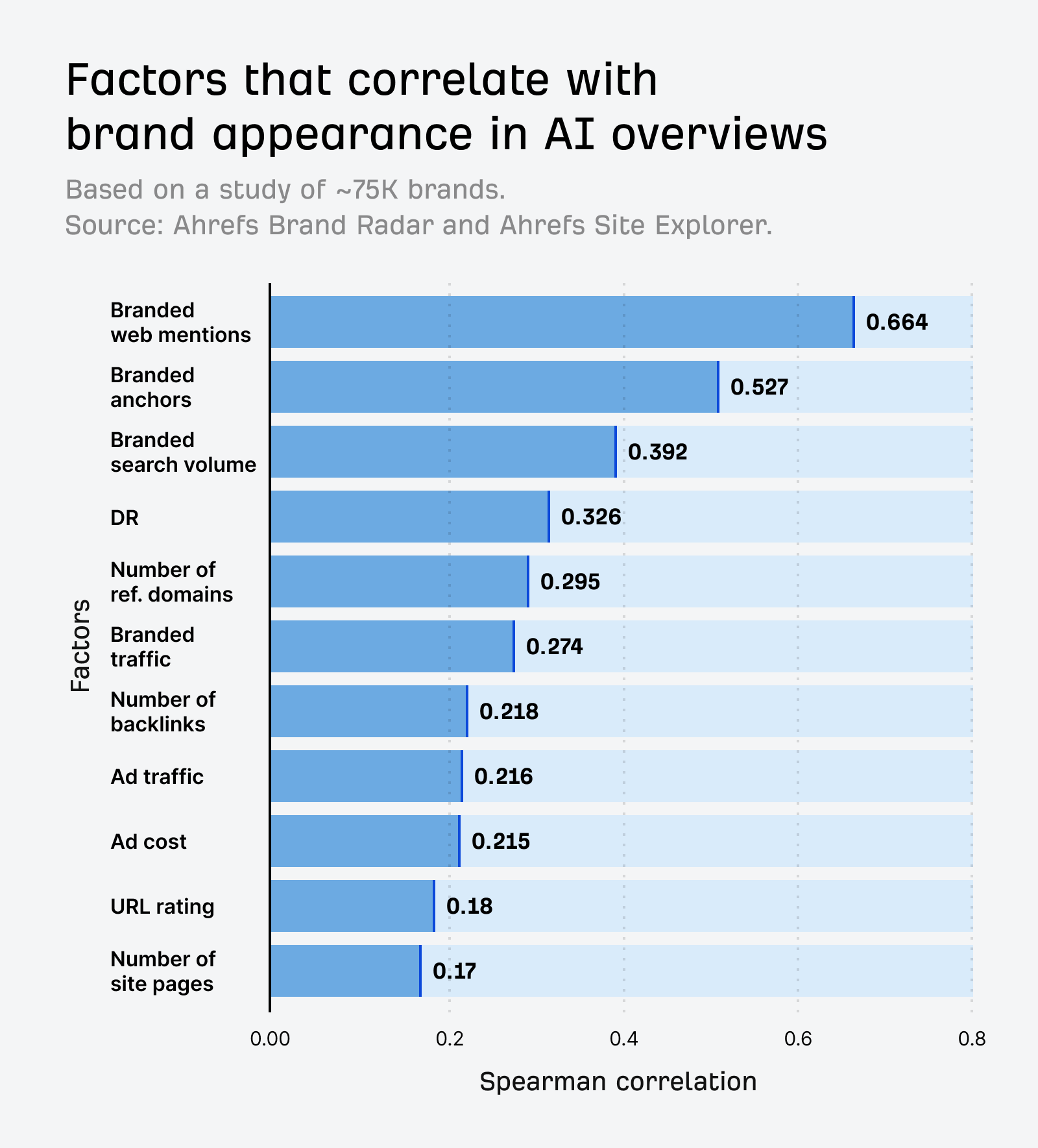
To find sites that often appear in AI answers, just plug their domain in Ahrefs’ Site Explorer and look at the AI citation count in the Overview report:
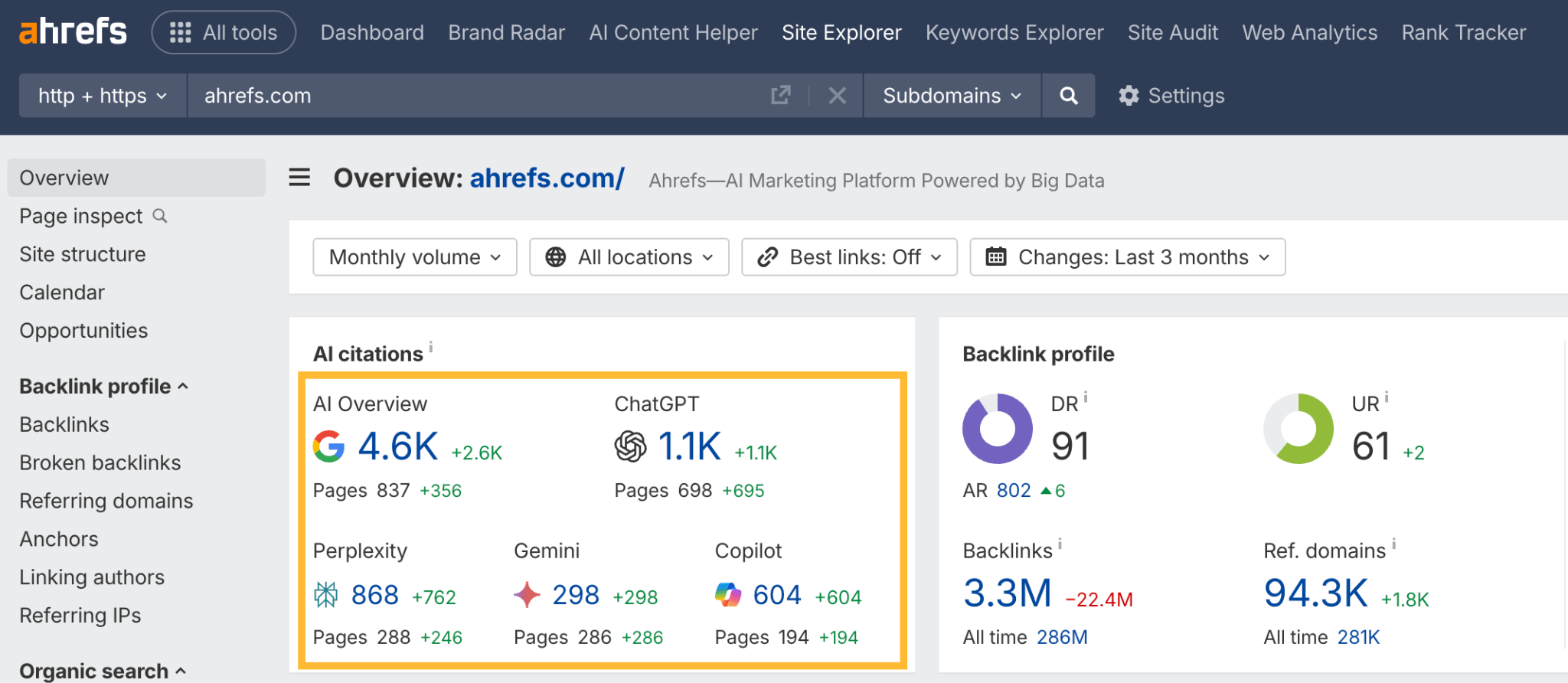
If you’re choosing between two sites with similar AI citations, consider:
- Domain Rating (DR): Still a solid measure of trustworthiness and popularity. It’s the number right next to AI Citations in Site Explorer.
- Branded search volume: Sites people actively search for often have more influence in AI citations. In Site Explorer, open the Overview report, scroll down a bit to the Entities graph, and select only the site’s brand name.
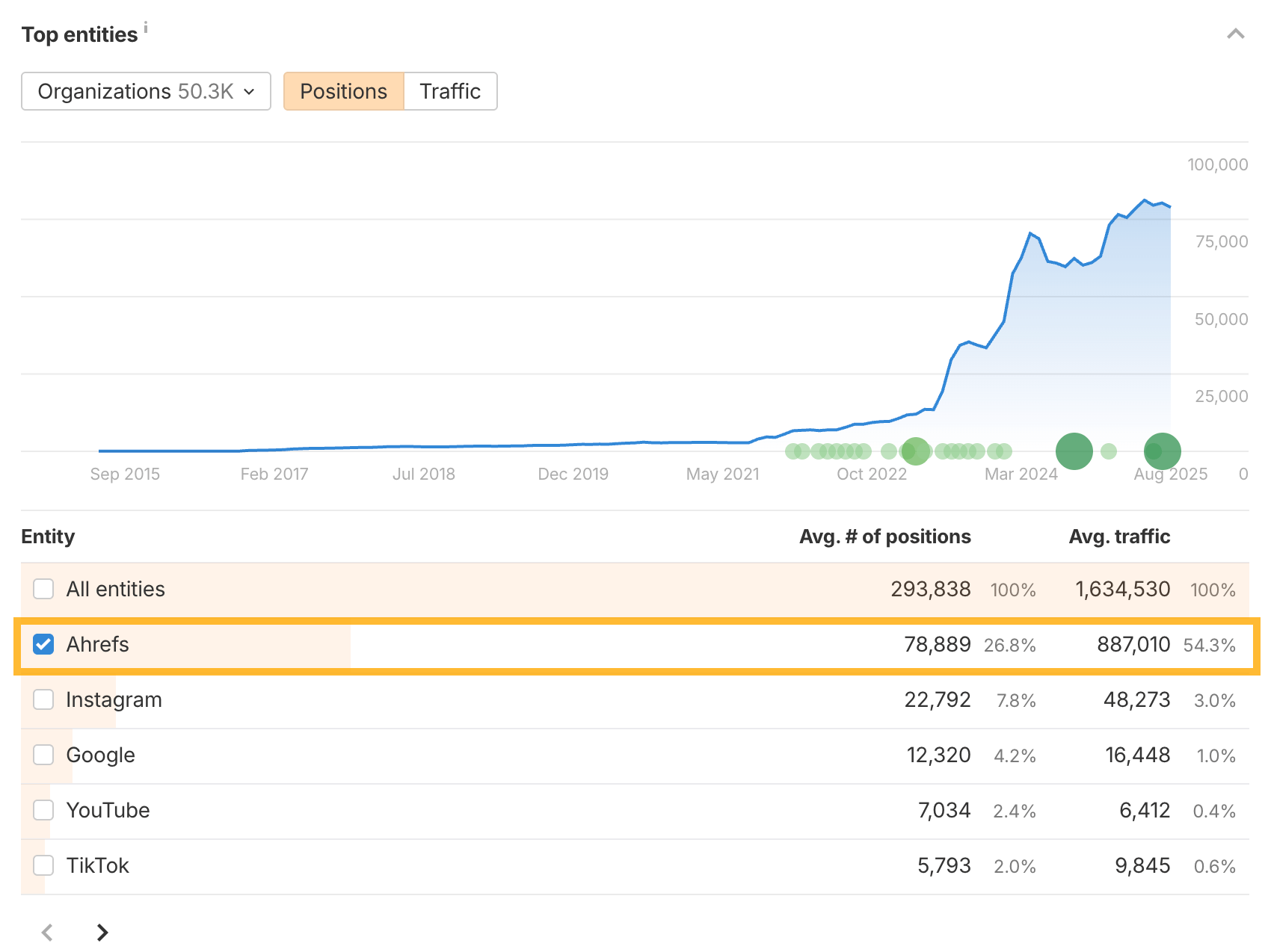
In a bit, I’ll explain how to find and close your AI visibility gap.
2. Create the type of content that does well in AI search
Not all content performs equally well in AI search. Our analysis of pages receiving AI traffic reveals clear patterns about what content types AI assistants prefer to cite.
The general trends across all sites:
Based on broad analysis, certain content types consistently earn the greatest proportion of AI traffic:
- “Best” content: 7.06% of AI traffic goes to pages with “best” in the title.
- “Top” lists: 5.5% of AI traffic.
- “Vs” comparisons: 4.88% of AI traffic.
- How-to guides: 6.35% of AI traffic.
- Product-focused pages: “Contact” (6.8%), “products” (6.43%), “product” (4.71%), and “services” (4.53%) pages.
But here’s the thing: every brand and industry is different. So I dug deeper into the last 3 months of our own data to see what type of content generates the most traffic for Ahrefs. I’d strongly recommend doing the same for your site.
| Content category | Total views | Engagement | Strategic insight |
|---|---|---|---|
| How-to guides | 7315 | 184 sec time on page | Bread-and-butter traffic drivers; AI assistants favor clear, actionable guides. |
| Data studies | 6134 | 207 sec time on page | High engagement; authoritative research performs well in AI results and invites further clicks. |
| Homepage | 2875 | 0.53 bounce rate (low) | Captures navigational queries; AI assistants surface brand entry points. |
| Listicles (tools) | 976 | 0.84 bounce rate (high) | Strong time on page; useful for tool discovery via AI assistants, but high bounce suggests single-visit utility. |
| Definition | 747 | 173 sec time on page | Fulfills direct informational queries; AI assistants use these for concise answers. |
| Listicles | 585 | 0.79 bounce rate (high) | Good at attracting curiosity clicks from AI summaries. |
| Product | 530 | 0.24 bounce rate (low) | Low bounce rate; AI assistants can drive qualified visitors directly to product-related pages. |
| Opinion / thought leadership | 282 | 214 sec time on page | Engaging for deeper reads; niche but valuable for brand authority in AI contexts. |
I think the sweet spot is creating a content mix that covers different user intentions. Some people want quick updates on trends, others want comprehensive tutorials they can bookmark, and some are looking for hard data to back up their decisions. If you only create one type of content, you’re probably missing out on citations from the other user groups.
So, start by auditing your existing content to see which of these categories you already have, then take a look at your own analytics to spot patterns. What content gets the most engagement from your audience? That’s probably where you should double down, but don’t ignore the other categories entirely.
You can find this data in Ahrefs’ Web Analytics (free in AWT). Just click on AI Search to see how visitors from this channel interact with your site.
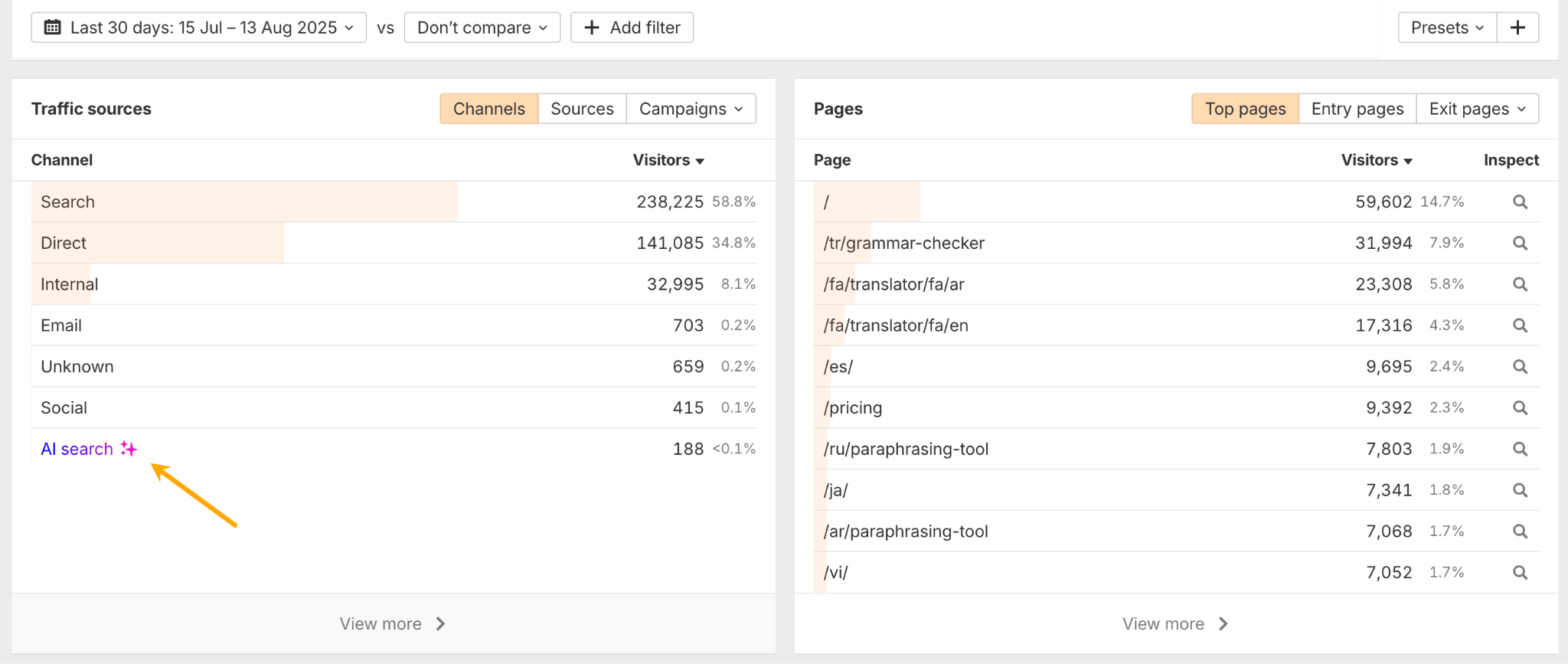
And here’s an extra tip: keep your core content fresh and up-to-date. We found that compared to traditional search results, AI assistants prefer citing fresher content.
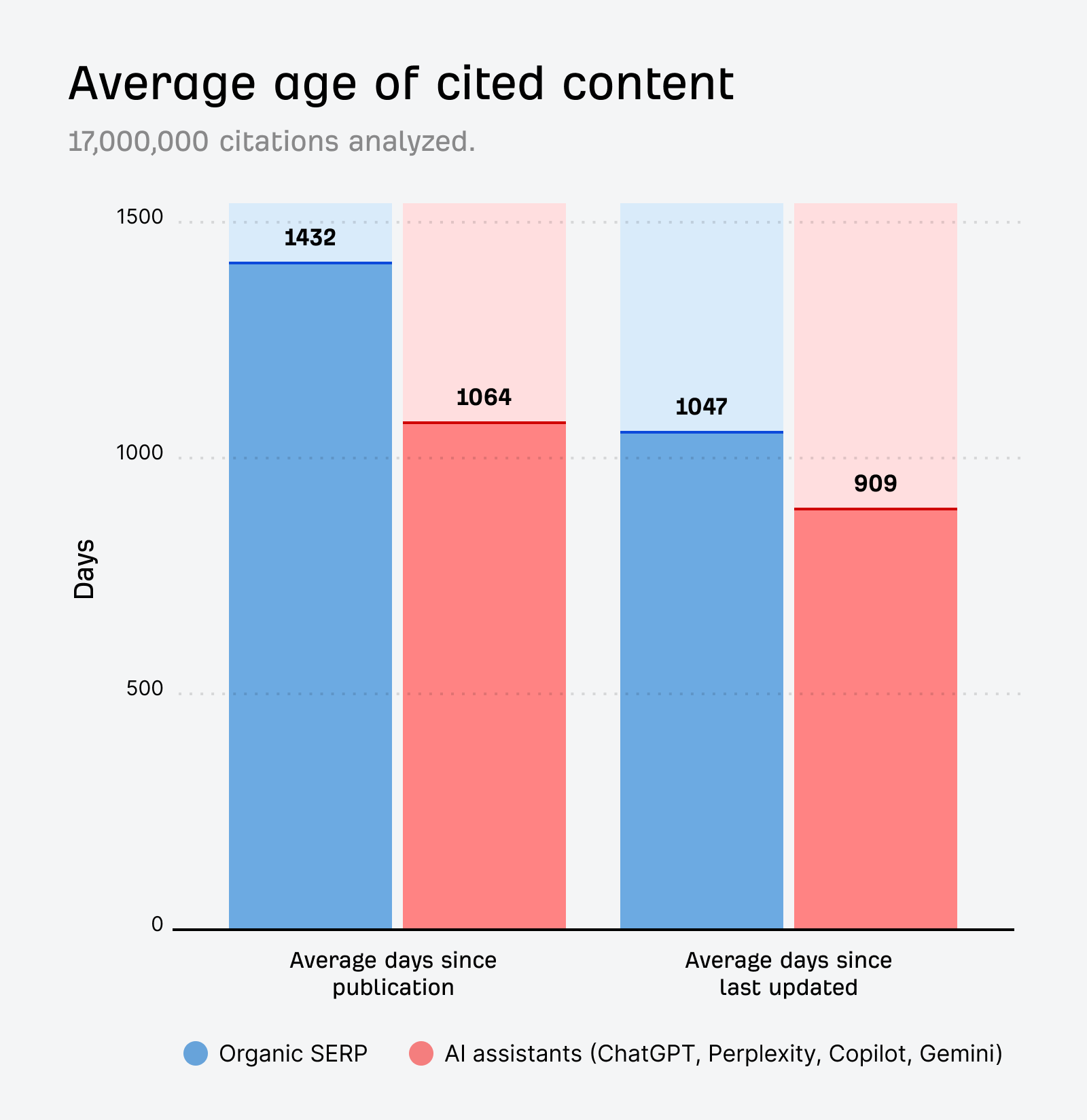
3. Create a great experience on your homepage and product landing pages
Did you know that over 80% of ahrefs.com referral traffic from AI search goes to just three content types? Those are free tools (mentioned before), product pages, and our homepage.
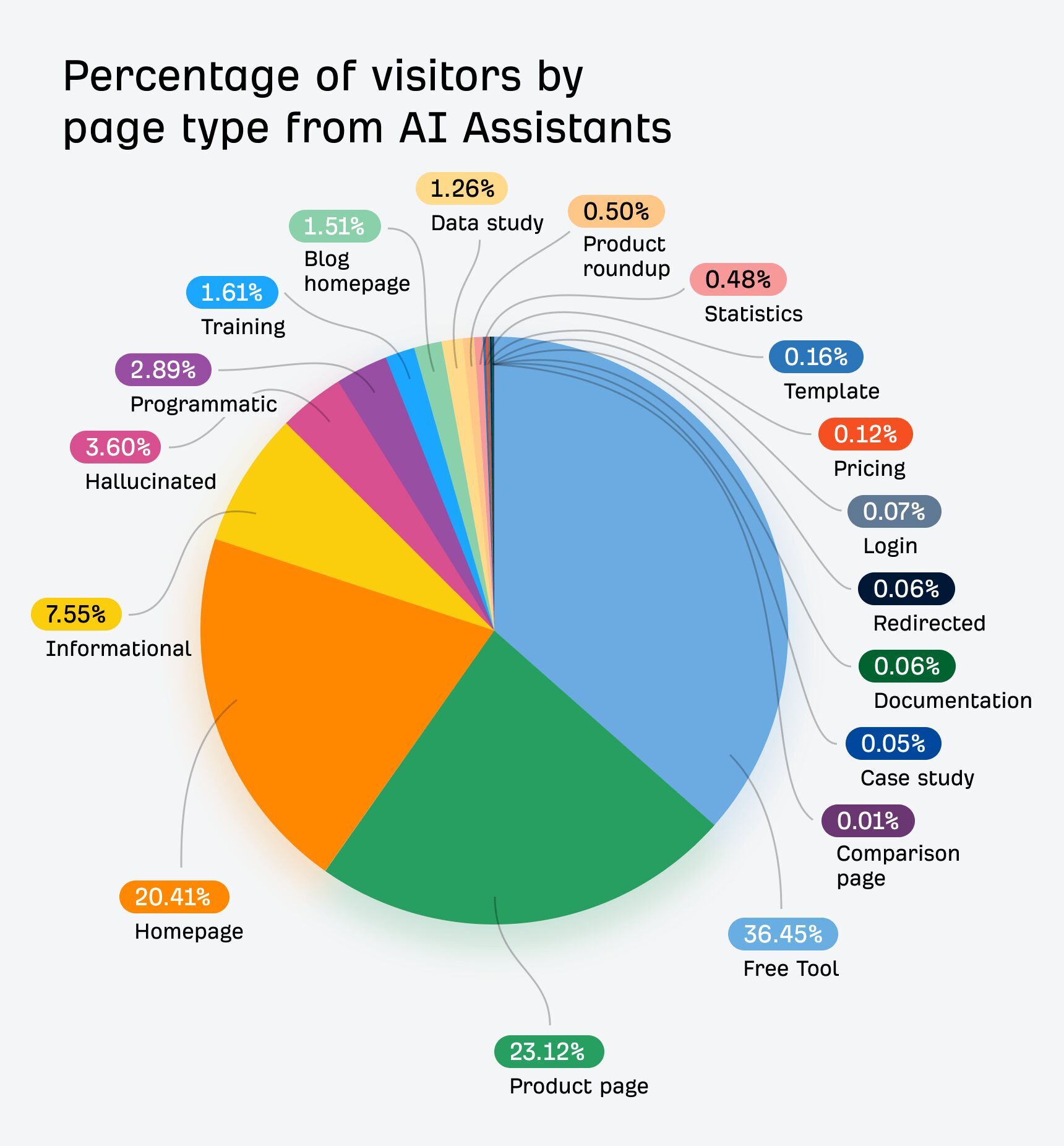
AI-generated traffic to your site will likely follow similar patterns. Since AI tools tend to guide users to a few key pages, it’s important to make sure those pages offer a great experience.
- Make what you do and why you’re valuable immediately obvious.
- Use headers, bullet points, and clear sections.
- Make it easy for both humans and AI to find your contact details.
- Create clear, factual product/service descriptions that AI can easily parse and cite.
4. Structure content for AI comprehension
AI models love structure and clarity. Here are a few simple rules for making your content AI-friendly.
Use clear formatting:
- Hierarchical headings (H1, H2, H3).
- Bullet points for lists.
- Short, factual statements.
Implement technical optimizations:
- Add structured data (schema markup) for FAQs and product information.
- Ensure fast page loading speeds.
- Make your site mobile-friendly.
- Don’t block AI bots from accessing your content.
- Avoid too much JavaScript (at the time of writing, most AI crawlers don’t render JavaScript).
Write for clarity:
- Use simple, direct language.
- Break up long paragraphs.
- Include specific facts and figures AI can cite.
- Answer common questions explicitly.
4. Go multi-platform
Our study on the most cited domains by AI revealed two platforms that can give you the highest reach for AI citations:
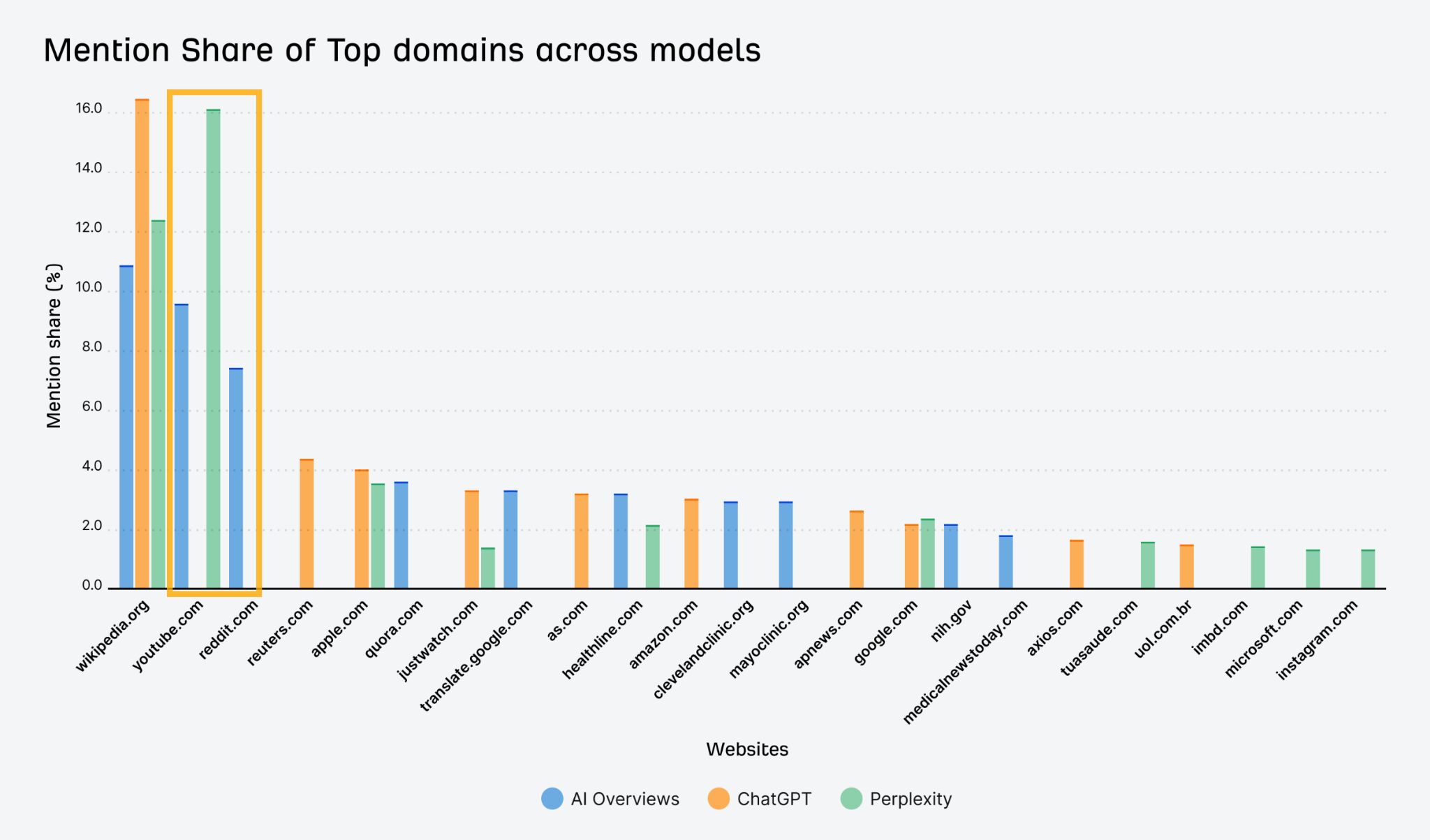
To start optimizing for Reddit, focus on threads that already have visibility in Google Search.
- Go to Ahrefs’ Site Explorer, enter “reddit.com”, and open the Organic keywords report.
- Use filters: positions 1-10, keyword includes (enter phrases related to your site). You can select a preferred location, too.
- Look for relevant keywords with a lot of traffic.
- Add thoughtful, useful answers to these high-traffic threads.
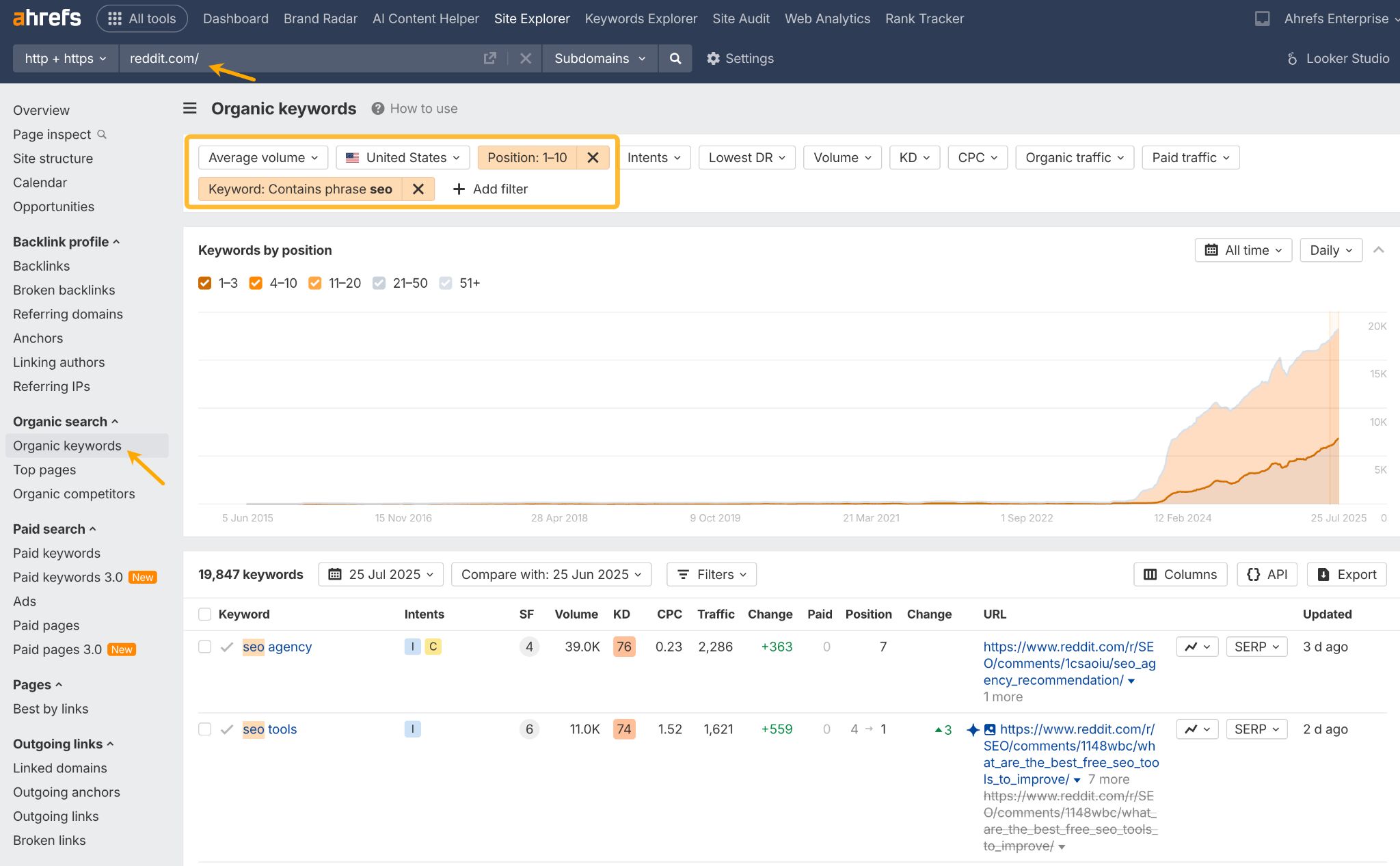
As for optimizing for YouTube, we’ve put together a complete guide that walks you through our video SEO strategy—the same one that helped us earn over 5.7 million organic views and 642,000 watch hours in 2024 alone.
5. Find your AI mention and citation gaps
One of the fastest ways to improve your GEO strategy is to see where competitors are succeeding in AI responses while you’re missing out.
I’ll show you how to do that with Ahrefs’ Brand Radar. It’s one of the fastest-growing tools in AI brand visibility, with 100M+ prompts, 5 AI indexes, and requires zero setup.
Finding your AI mention gap (competitors mentioned, but not you)
To find pages that mention your competitors but not you (your AI mention gap), add your competitors to Brand Radar, hover on any AI chart, and click on “Others only”.
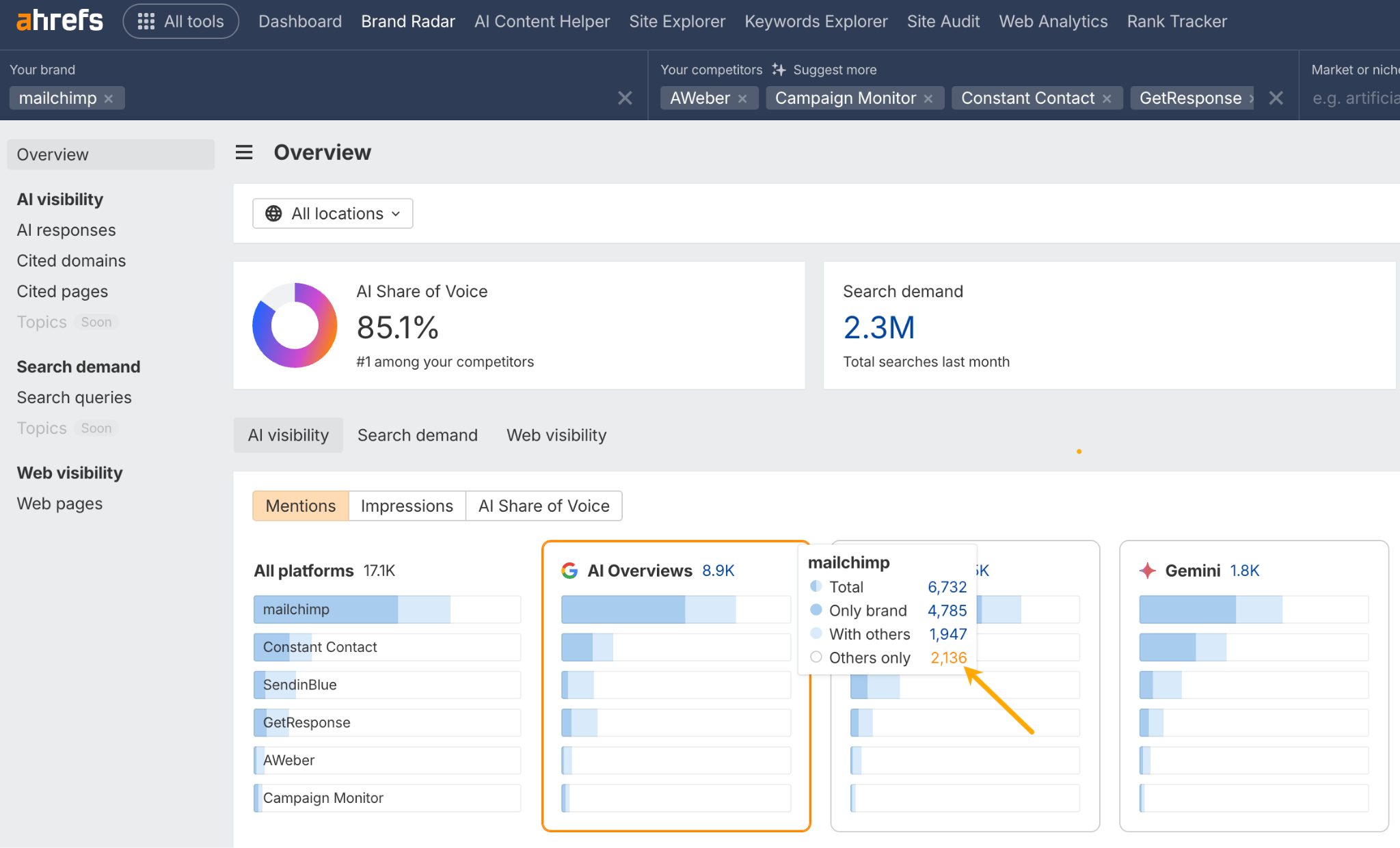
Next, click on the Cited pages report to see websites you could reach out to to close your AI mention gap.
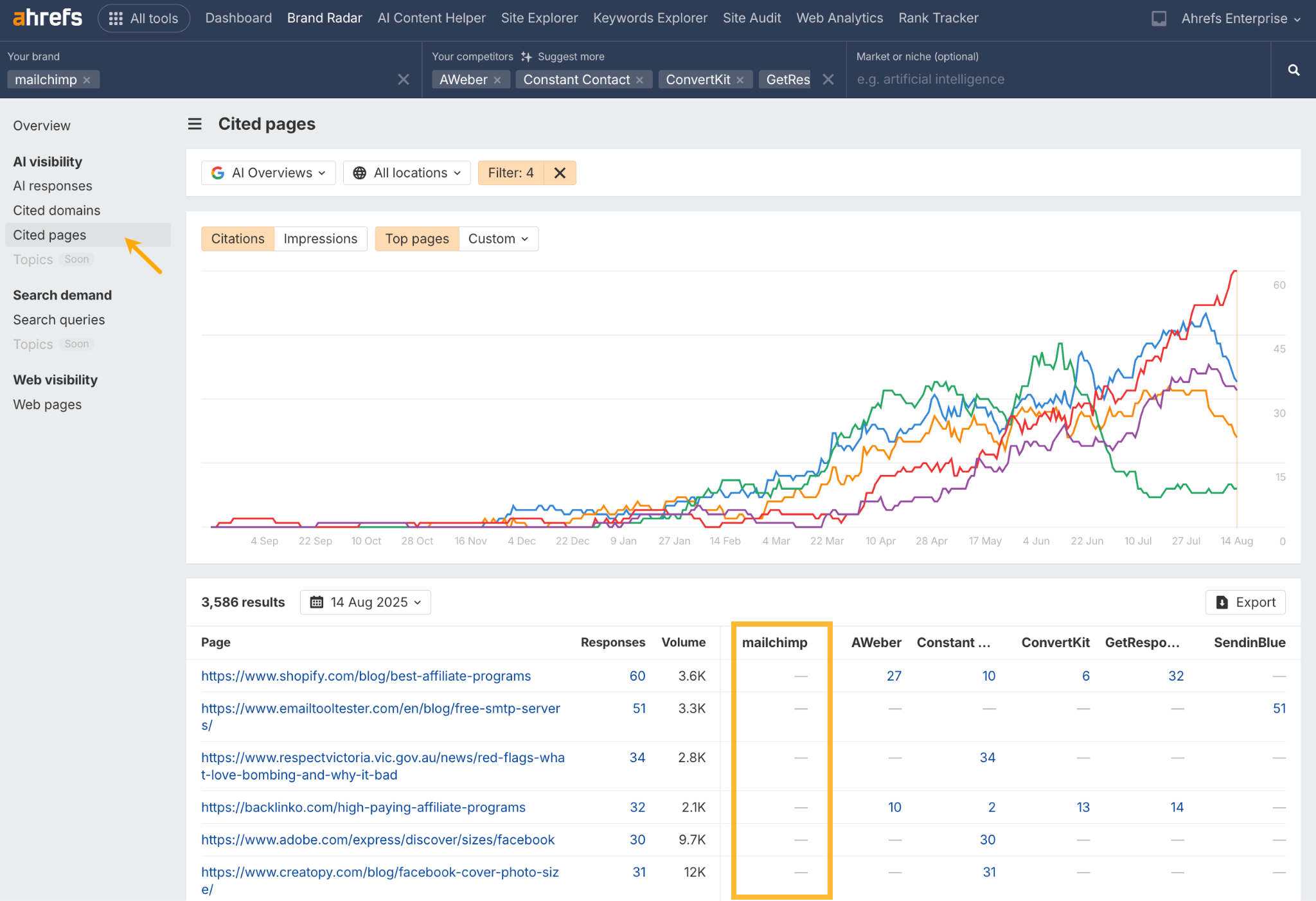
Finding your AI citation gap (competitors cited in AI answers, but not you)
- Start by clearing all the top-level filters in Brand Radar.
- Go to the Cited pages report.
- Apply the competitor filter at the bottom like I’ve shown in the screenshot:
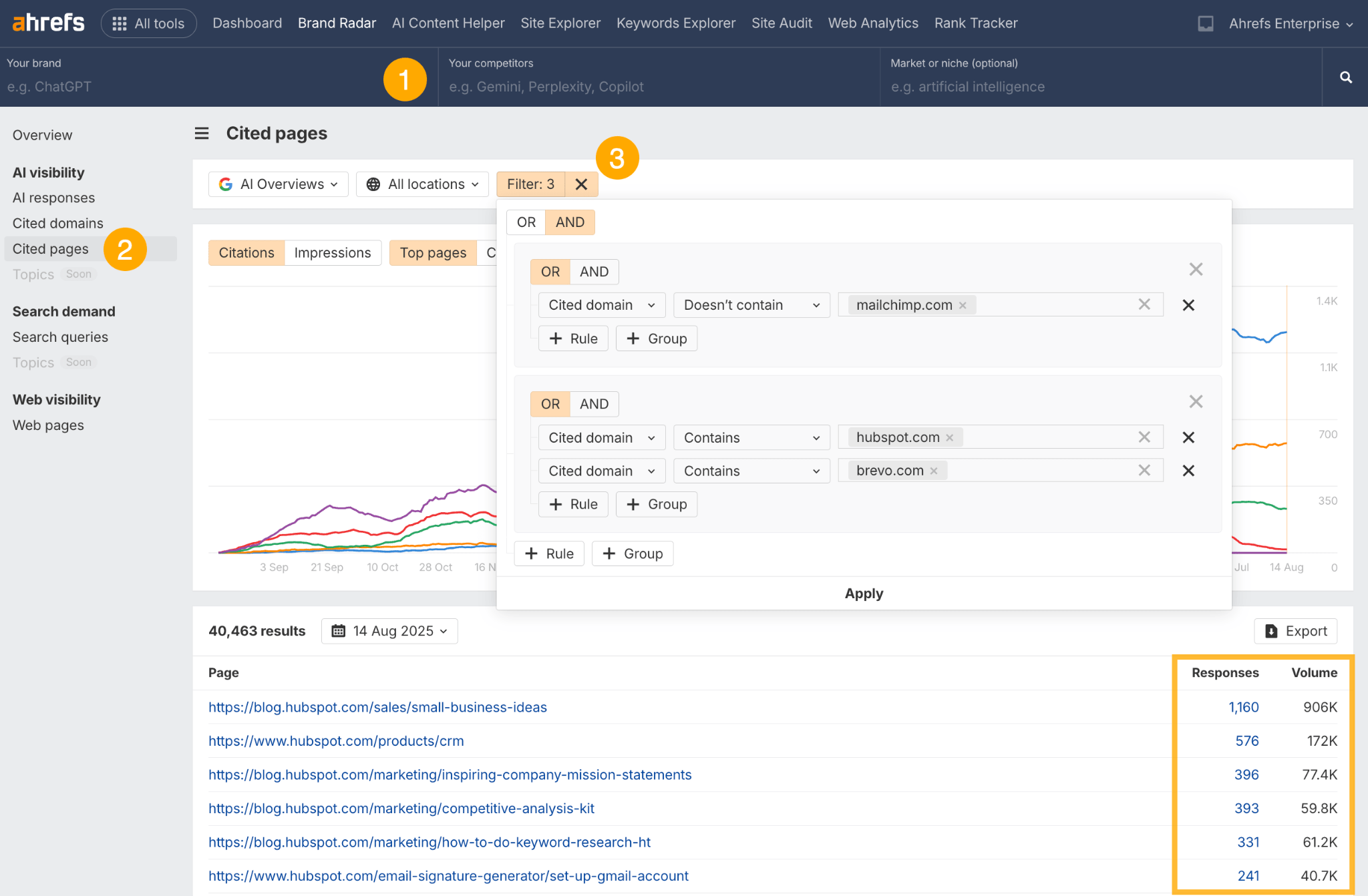
This gives you a list of pages showing how many AI responses mentioned your competitors and the total search volume of those queries. Now you know exactly which content topics and pages to target with your own superior content.
Traditional SEO metrics like rankings won’t tell the full GEO story. You need a tool like Brand Radar to track how AI systems interact with your brand.
AI mentions
These are when AI assistants include your brand in their responses, whether they link back to you or not. Think of it as the new word-of-mouth marketing—the more your name comes up in AI answers, the more likely people are to remember and consider your brand.
If you’re using Ahrefs’ Brand Radar, just plug in your brand name and your competitors’ names (the tool can even suggest competing brands using AI).
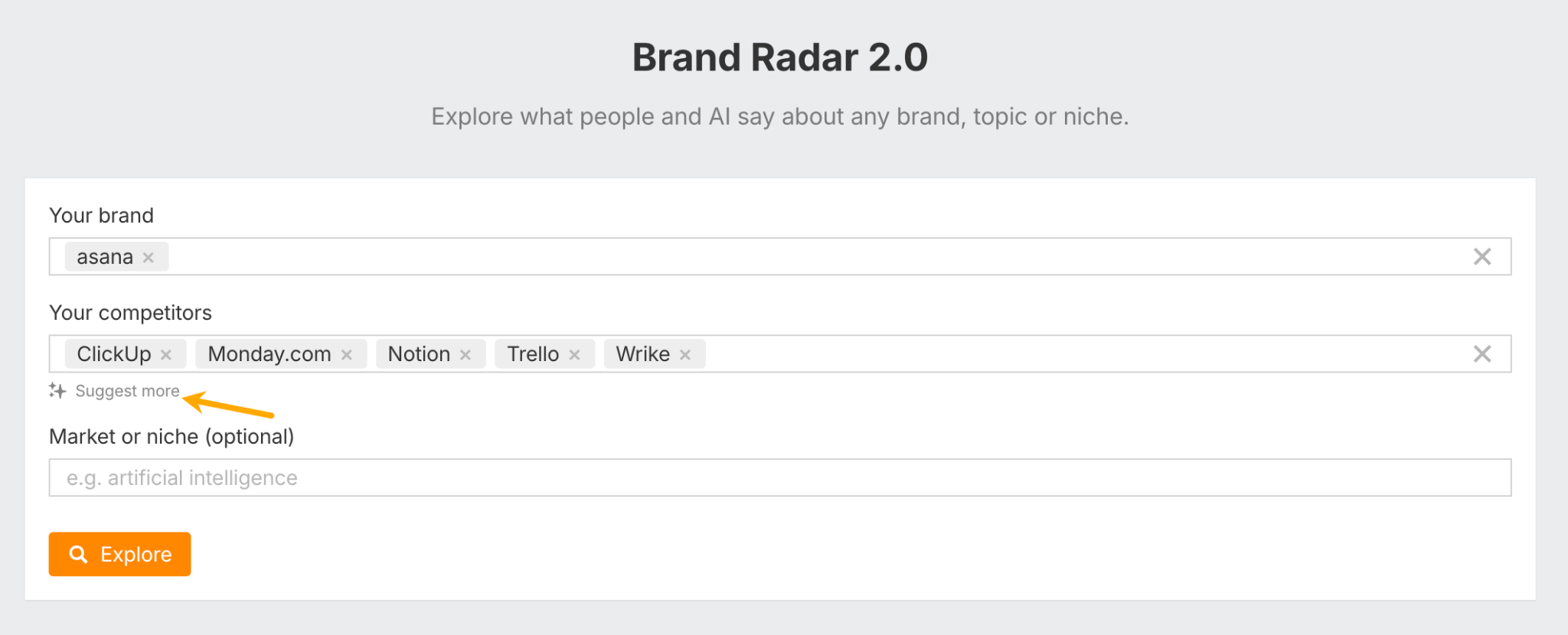
You’ll see a dashboard showing how often your brand is mentioned and the total potential reach of those mentions.
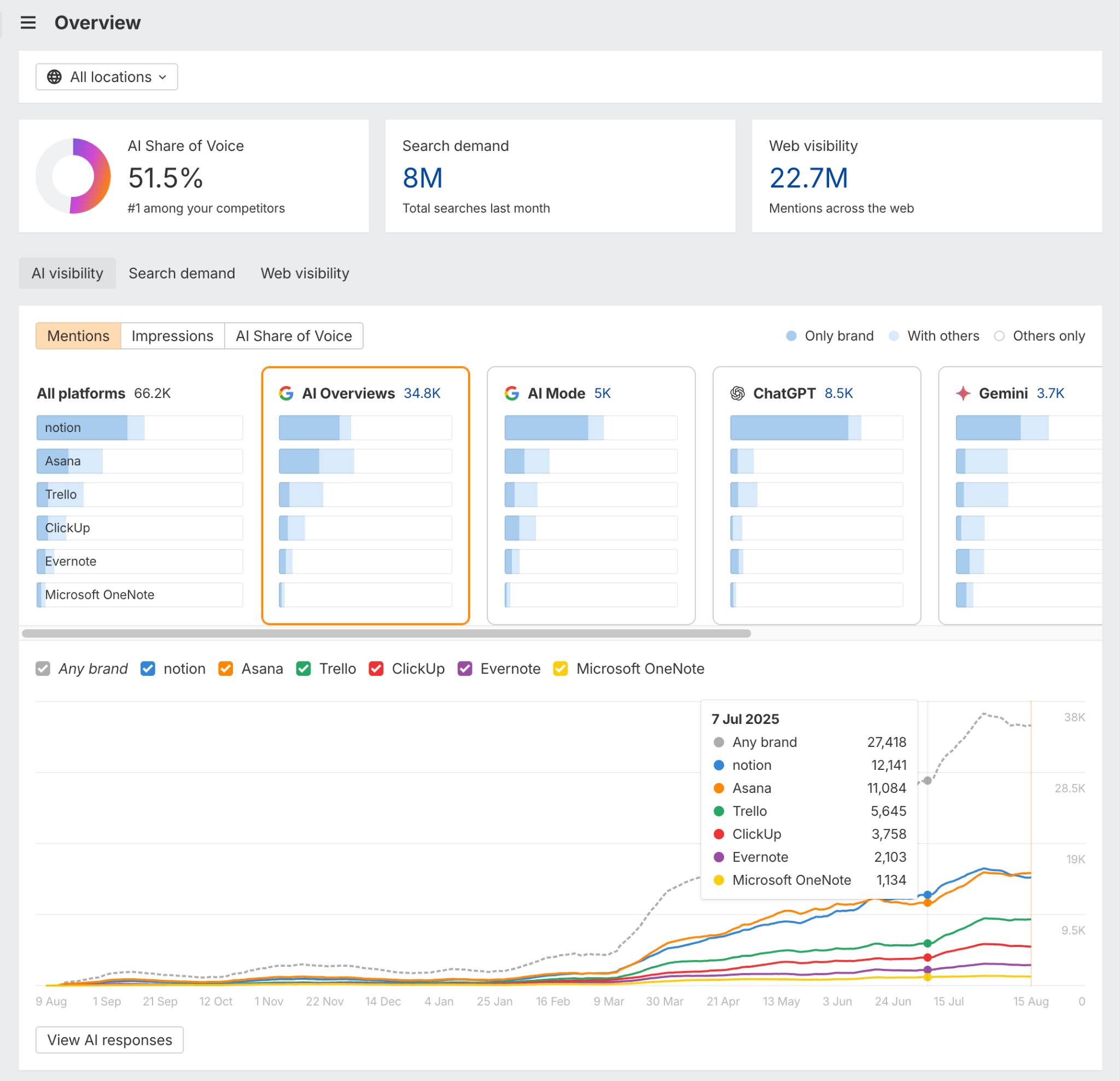
Specifically, you’ll see:
- Mentions: number of results that mention the entity at least once.
- Impressions: mentions weighted by Google search volume to estimate potential exposure.
- AI share of voice: percentage of brand impressions out of the total impressions for responses that mention any tracked brand.
You can also see how visible your brand is within specific topics. For example, let’s check Mailchimp’s AI share of voice as a social media tool—a feature not everyone knows about. All it takes is adding “social media tool” to the top-level filters.
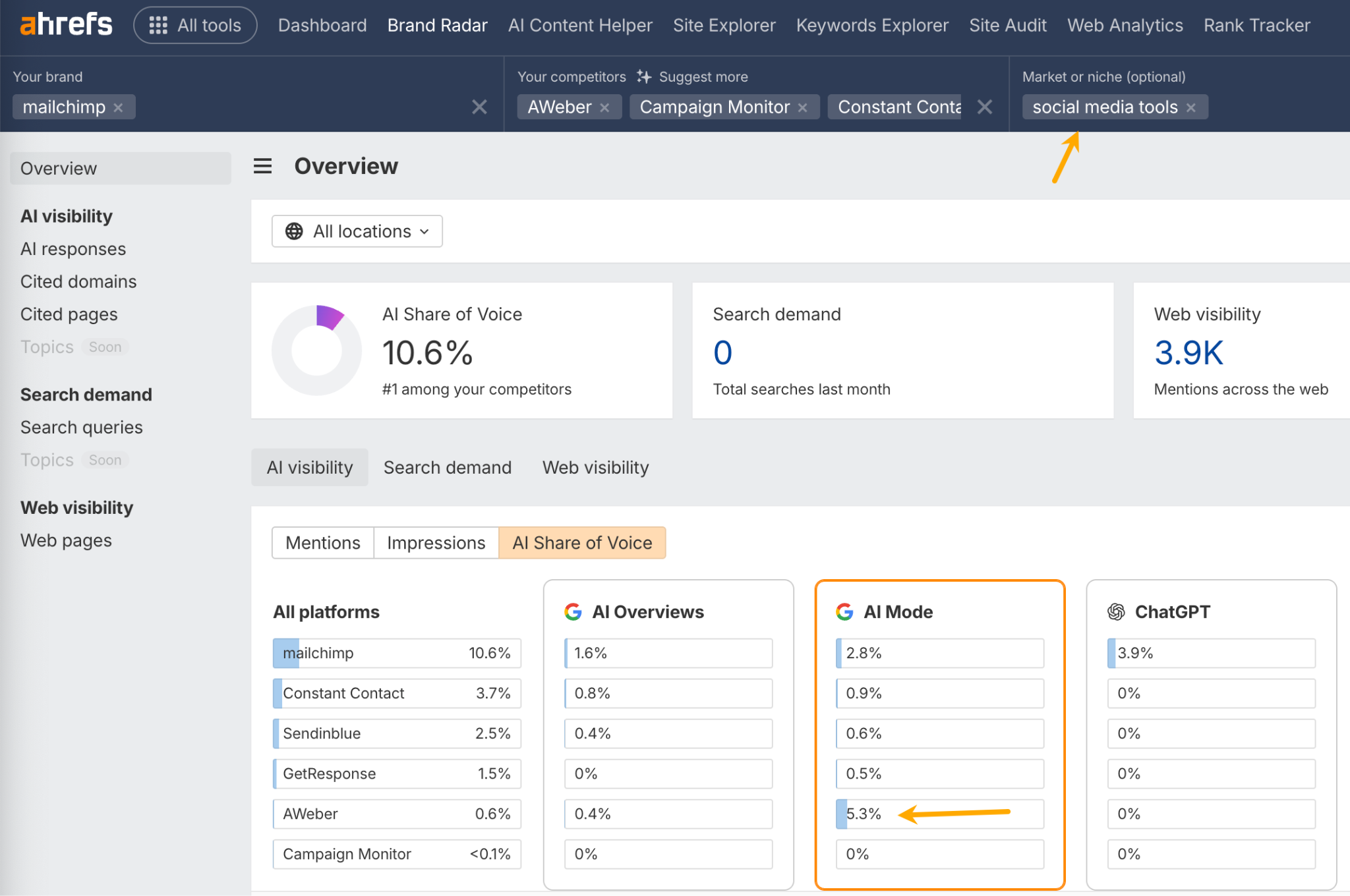
We can see that it has the biggest visibility out of the competition, except for AI Mode, where another brand has more reach.
You can also track multiple brands from the same company and benchmark them against competitors at the same time.
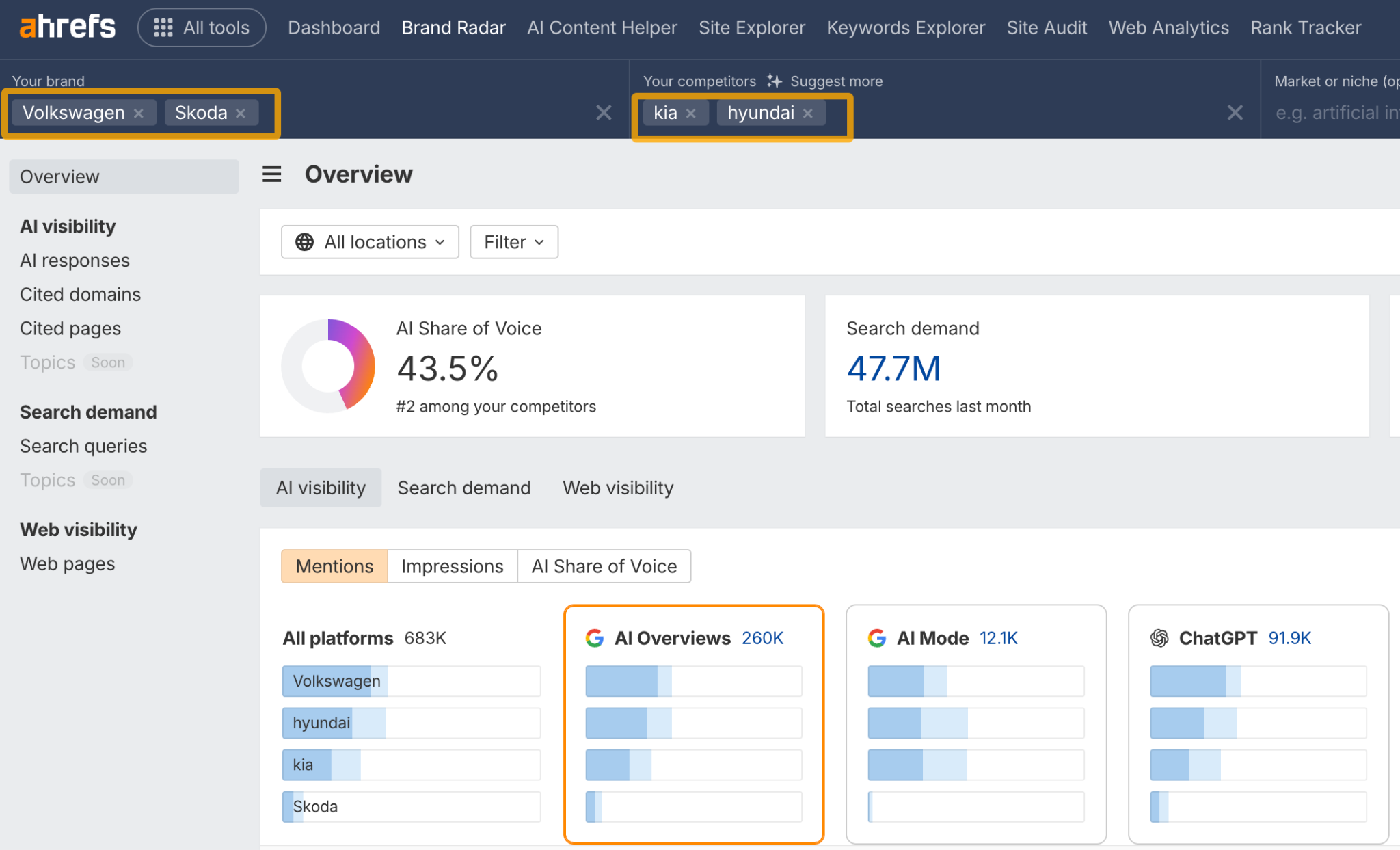
AI citations
This is when your specific content gets referenced as a source in AI responses.
For a quick check of your citation performance, head to Ahrefs’ Site Explorer and enter your domain. You’ll see how many times your pages have been cited, and you can click through to see which content AI tools are picking up and in what context.
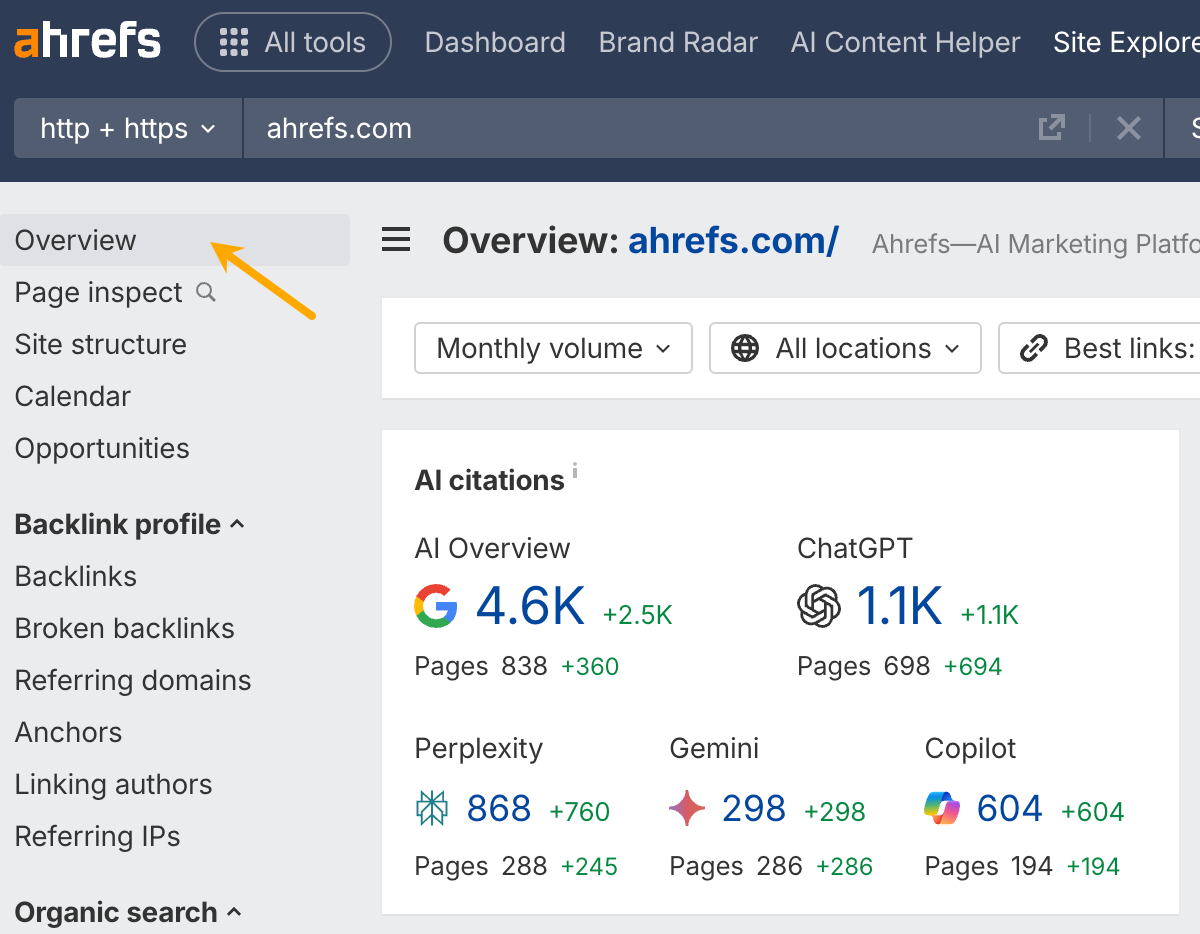
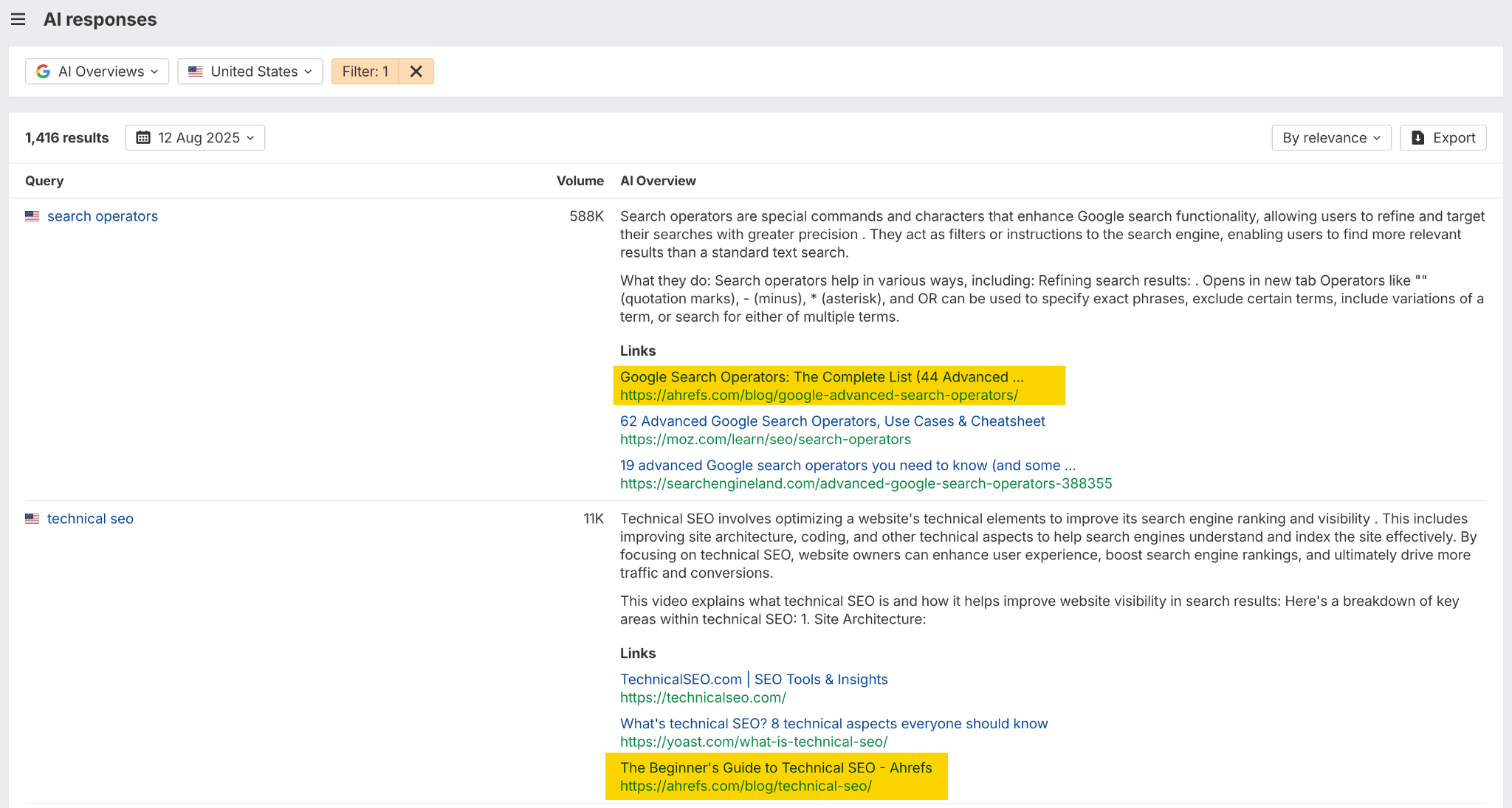
Use citation patterns to understand what type of content AI prefers from your site, then create more content in those winning formats.
AI-driven traffic
Yes, direct traffic from AI tools is still relatively small, and often poorly attributed by AI. But when it does come, it’s often higher quality. These visitors have already been pre-qualified by AI, so they tend to be more engaged and more likely to convert.
In Ahrefs’ Web Analytics, AI traffic is simple to track because it’s already listed as one of the built-in traffic sources. You don’t need to mess with UTM tags or regex. Just click on it to see analytics for this channel.
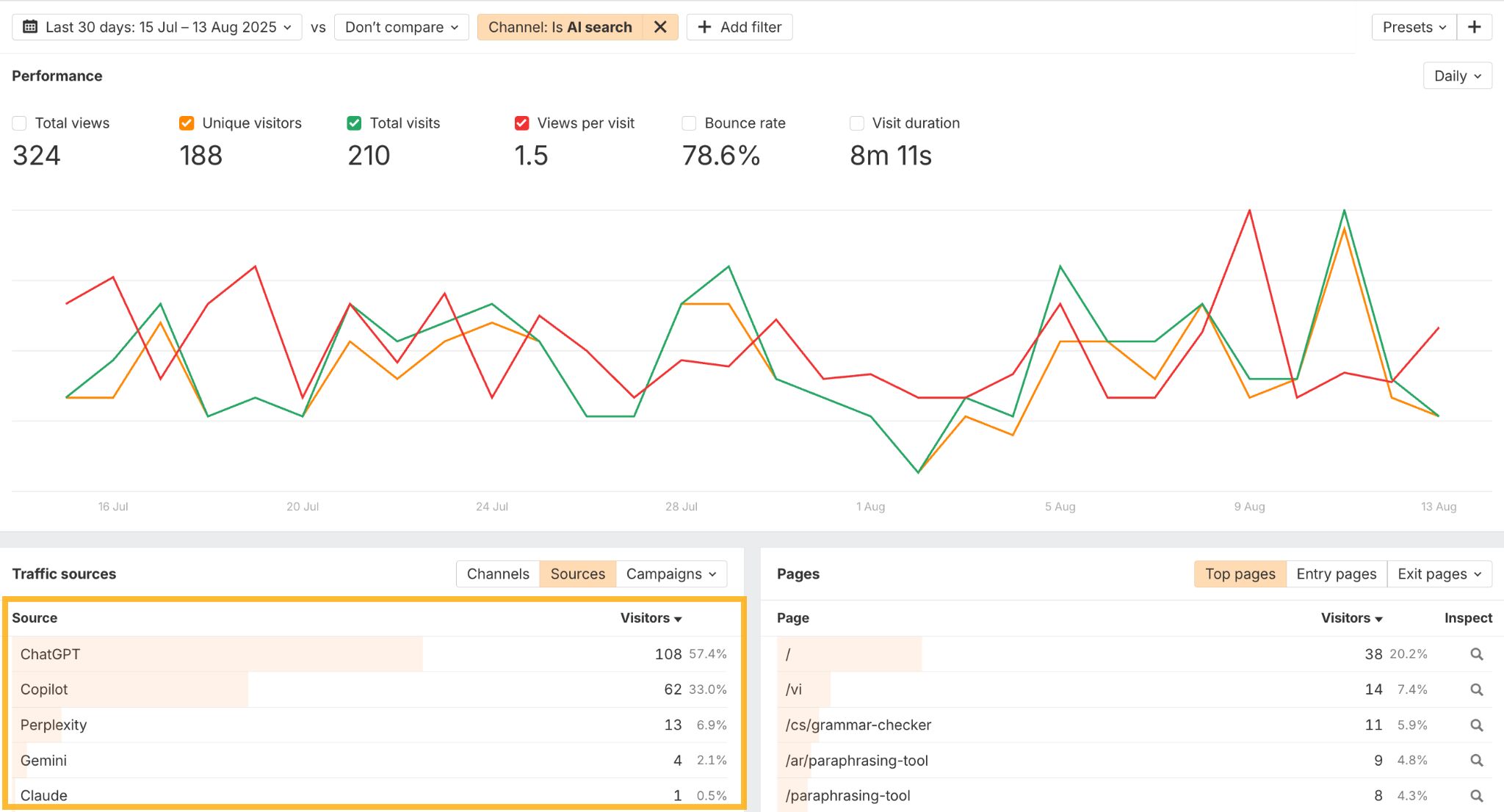
Honestly, the GEO landscape is changing so fast it’s hard to keep up. But here are the trends I’m seeing that could shape what comes next.
Search engines might become even more important to AI, not less
This is the big one that caught my attention. OpenAI made a fascinating choice with GPT-5—they designed it to be “intelligent, not knowledgeable.” Instead of cramming every fact into the model, they focused on making it great at reasoning and then let it search for information when it needs it.
Without access to search, GPT-5 is reportedly “virtually useless.” That might sound like a limitation, but training models to memorize everything has become ridiculously expensive and just isn’t sustainable anymore.
If other companies follow OpenAI’s lead (and they probably will), it means traditional SEO could become even more valuable for getting AI citations. Here’s a deep dive on why this matters
Google’s probably going to push AI Mode everywhere
Right now, AI Mode is mostly available in the US and UK, but Google usually doesn’t keep major features limited to just a few countries. It could eventually become the default way people search, just like Google’s CEO hinted.
But maybe it won’t be as disruptive as it sounds. I’ve already seen a couple of our articles show up in AI Mode without any AI Mode SEO, which backs up what Gary Illyes said: good old-fashioned SEO might still be all you need.
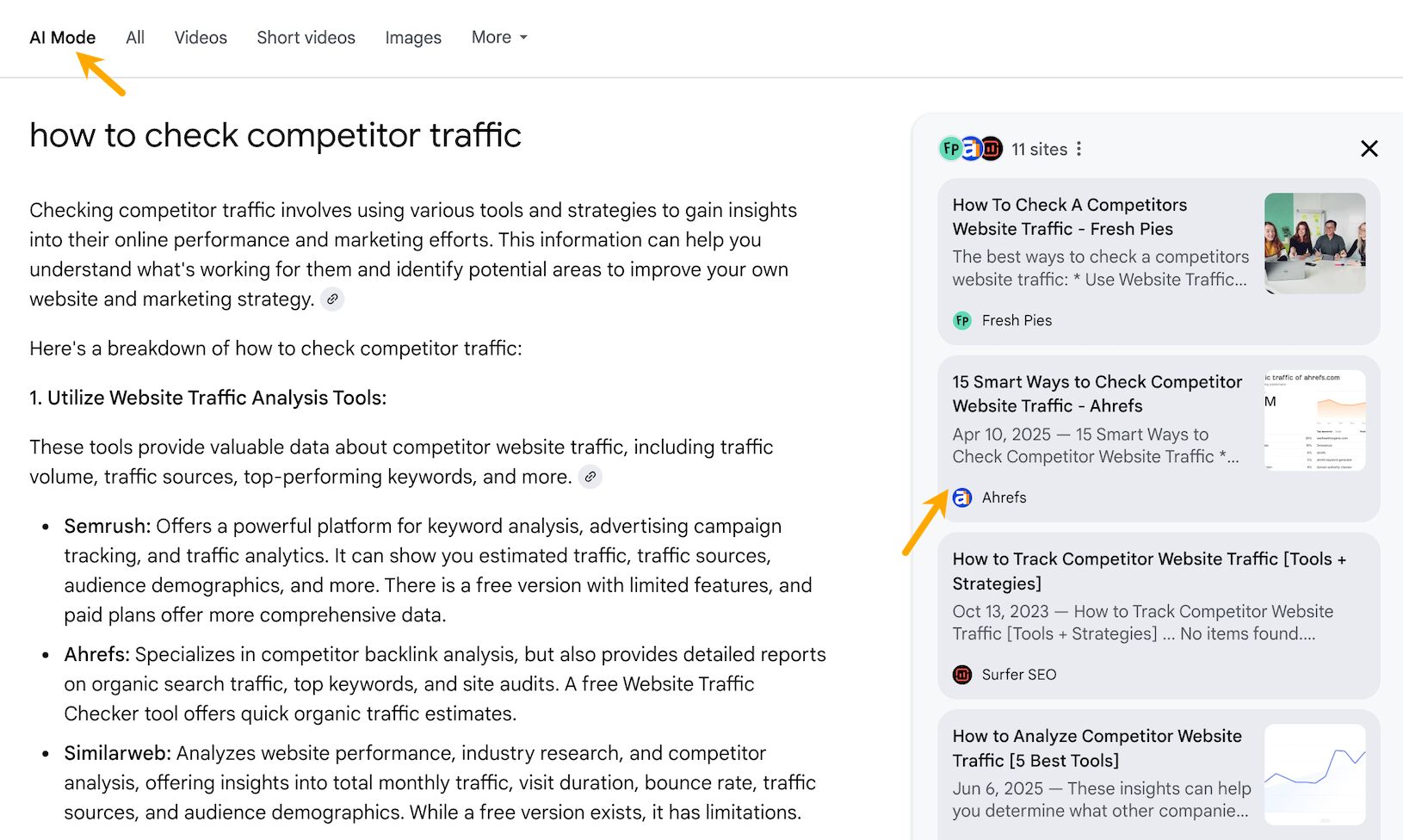
AI is going to start doing things, not just answering questions
The next wave is about AI actually completing tasks for people. Think agents that can compare products, negotiate prices, or even buy things for you. If that becomes the norm, being visible to AI could mean a lot more than just showing up in search results.
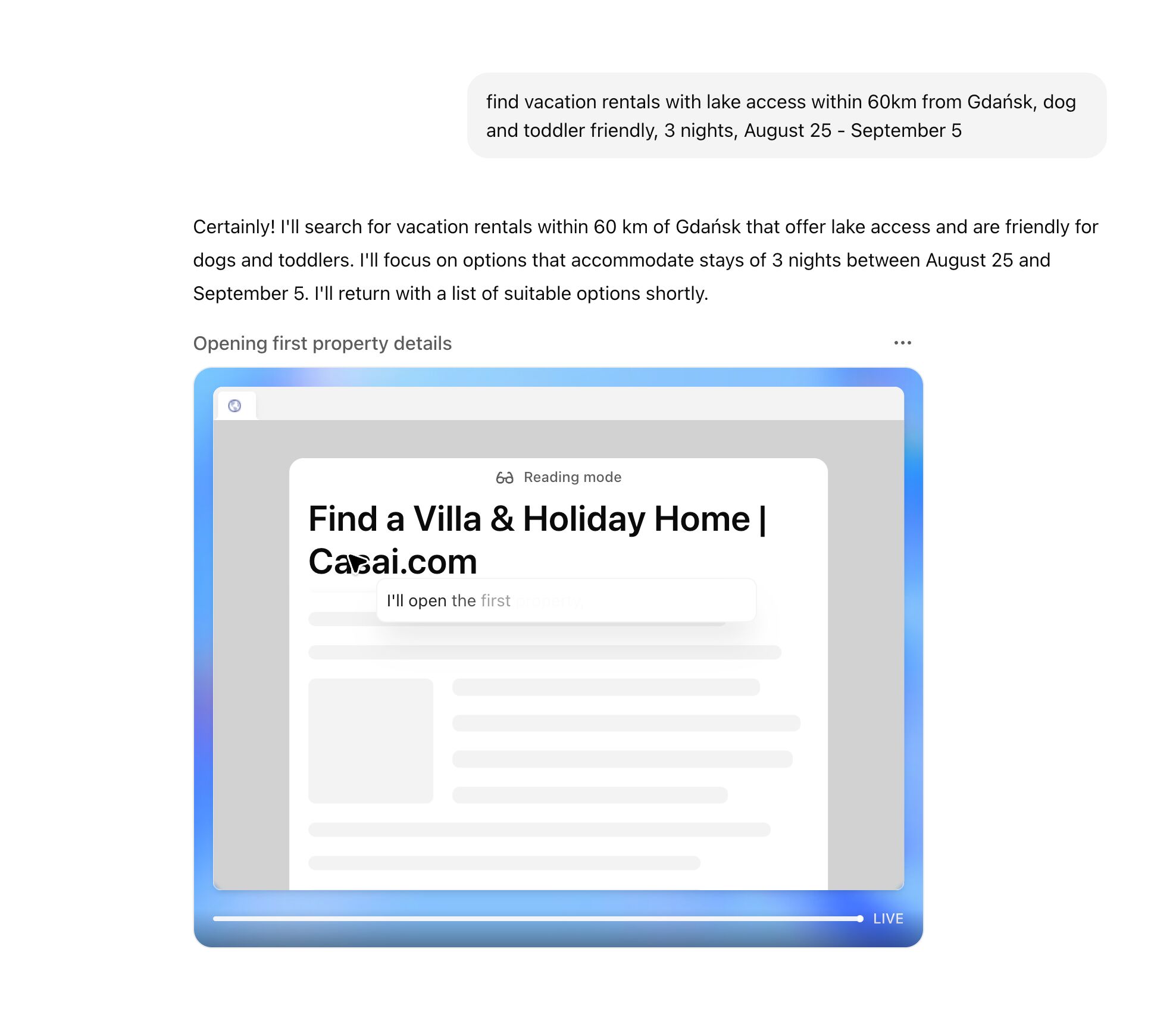
Spam detection will get smarter (but how forgiving will it be?)
Just like Google got better at spotting spam and link schemes, AI systems will definitely get better at identifying attempts to game their responses. The big question mark is how long AI systems might “remember” if you’ve tried to manipulate them. Will they be forgiving like Google eventually became, or will they hold grudges longer?
Final thoughts
Treat GEO as an extension of your existing SEO strategy. After all, it’s basically SEO for AI search. The fundamentals—great content, clear structure, topical authority—work for both. You’re just expanding your definition of success beyond clicks to include AI citations and brand mentions.
AI is moving so fast that even the people building it can’t always keep up. Following blogs like ours is one way to stay in the loop.
Got questions or comments? Let me know on LinkedIn.


















